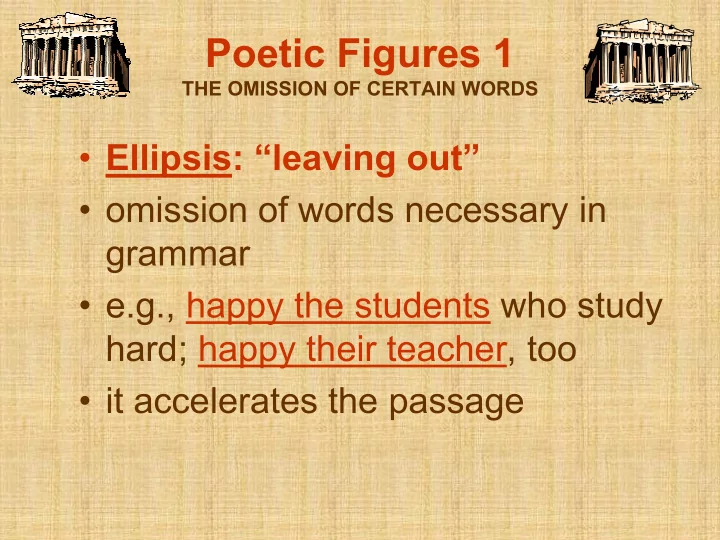

Poetic Figures 1 THE OMISSION OF CERTAIN WORDS • Ellipsis: “leaving out” • omission of words necessary in grammar • e.g., happy the students who study hard; happy their teacher, too • it accelerates the passage
Poetic Figures 1 THE OMISSION OF CERTAIN WORDS • Asyndeton: “no conjunction” • omission of conjunctions • e.g., “Come to class, do the reading, study hard: these are the keys to success in college.” • like bullets, a rapid-fire list creates a strong sense of urgency
Poetic Figures 1 THE OMISSION OF CERTAIN WORDS • Aposiopesis: “silencing off” • breaking off before the end of a sentence or thought • e.g., “You think you can just walk in late to class, young man? Do I have to remind you that — why am I wasting my breath!” • shows a sudden shift in emotion
Poetic Figures 2 EXCESSIVE WORDS • Hyperbole: “overthrow” • exaggeration and overstatement • e.g., “This class is killing me! I’d rather eat nails than read one more page of this assignment!” • shows strong emotion—or in some cases (like ancient epic), grandeur
Poetic Figures 2 EXCESSIVE WORDS • Polysyndeton: “many conjunctions” • the use of extra conjunctions • e.g., this week I have a paper due, and two books to read, and a lab, and a project, and three tests! • each new item adds weight to the speaker’s argument
Poetic Figures 2 EXCESSIVE WORDS • Apostrophe: “turn away” • addressing a person or object that is absent or far off • e.g., “Gods of the Underworld, rise and take me now!” • it shows extreme emotion, often a sense of desperation/helplessness
Poetic Figures 3 ANALOGIES AND COMPARISONS • Simile: “similar (things)” • the explicit comparison of two things (“like,” “as”) • e.g., “Float like a butterfly, sting like a bee” • it calls attention to the comparison itself, and thus the speaker’s use of language and poetry
Poetic Figures 3 ANALOGIES AND COMPARISONS • Metaphor: “be in a changed form” • the implicit comparison of two things • e.g., “It’s an oven in here. My hair is plastered to my head, my brain is addled and my feet are on fire.” • focuses on the point being made more than the speaker’s poetic skill
Poetic Figures 3 ANALOGIES AND COMPARISONS • Personification: “putting a mask on something” • endowing a non-human thing with human qualities • e.g., This book really talks to me. Time flew by as I was reading it. • it humanizes the world at large and makes it seem more accessible
Poetic Figures 4 INCOMPLETE TRUTHS • Irony: “speaker’s art” • a statement which implies the opposite of what it says • e.g., “Sure, professor, Gen Ed classes like yours are the reason I came to college! Money means nothing to us young people.” • it shows a subordinate’s anger
Poetic Figures 4 INCOMPLETE TRUTHS • Oxymoron: “sharp-blunt” • juxtaposed opposites • e.g., hurry slowly and embrace from a distance that genuine imitation of Aphrodite you prefer! • it leaves a tension (often an absurdity) unresolved
Poetic Figures 4 INCOMPLETE TRUTHS • Euphemism: “nice speech” • a nice way of referring to something unpleasant • e.g., the Eumenides didn’t pass away—they’re just in the bathroom • it cushions a harsh blow or softens a vivid image in the reader’s mind
Poetic Figures 4 INCOMPLETE TRUTHS • Synecdoche: “association” • using a part of something to represent the whole • e.g., the pen may be mightier than the sword, but girls only want a guy with wheels! • it points to the most important part of something
Recommend
More recommend